It’s been over two months now that I’ve been using an E90 – after the usual few weeks leading up to local launch and a break to try out some other gear, I ended up bringing one with me on vacation, and that served as an excellent field test.
And since today is my final day of freedom before heading back for another long and stressful stint in corporate land, I thought I ought to expand on my current set of notes regarding the device.
To be completely honest, I originally had in mind picking up an E61i to bring along, since it is closer to the BlackBerry form factor – and if there is one thing you don’t usually want to carry on vacation, it’s a bulky phone. The E61i is not tiny by any means, but it’s passable.
But as it happened, it was simpler to get an E90 again. And after three weeks of using it as a laptop replacement for reading e-mail, keeping track of news, posting links and researching topics of interest, it kind of grew on me.
On The Level
Mind you, it’s nothing like the old Communicators – in fact, the subtle ways in which Nokia managed to render it inferior to old Series 80 devices and infuriate pretty much every single hard-core Communicator user out there are the stuff of legend, and shall not be recounted here.
Suffice it to say that there are times when, for all its HSDPA goodness and reasonably good Exchange support, it is as dumb, slow and unrewarding as the proverbial brick it is often compared to.
If want to know more about the genesis of it, I recommend this piece on how infighting and loss of focus helped Nokia cripple what is probably their most powerful device right now.
Nevertheless, once you get over your frustration with the completely obtuse way in which Nokia stuffed Series 60 applications into the device (by dint of moving buttons around without actually adapting the software), it almost works1.
Flogging a Dead Keyboard – Or Is It The Cow Inside?
On the physical side, writing on its keyboard is a challenge in many ways – not the least of which is the extremely poor touch, which renders the whole experience disagreeable and finicky.
I find it nearly impossible to locate the preposterously tiny dimples on the F and J keys or position my fingers in a way where I know which key I’m going to hit next by touch alone, which slows me down tremendously – and the bad impression is compounded by the rather unimpressive tactile feedback, somewhat akin to month-old marshmallows.
Even after several weeks of use, having to type anything on it was a chore, and I found myself more than once clipping my sentences just to get it over with2.
But I cannot fault the hardware alone for the slow, quasi bovine fashion in which the device responds to a key press. Besides the e-mail client (which is also given to bouts of slowness), the built-in Active Notes application was slow, unresponsive and cluttered the screen with useless frills – i.e., wasting an entire line of the screen with a pointless border.
And I would occasionally howl in frustration not just at the device’s sluggish text editing abilities but also at the auto capitalization featurette, which has got to be one of the dumbest, most asinine things ever to grace a full-keyboard device.
It needs an off switch, and by Jove, if Nokia can cram a hundred useless options into their UI, they might as well add something to deal with this.
Surf’s Up
But, of course, there’s something to be said for having an 800×352 screen, and using the new Opera Mini Beta 2 on it (in both portrait and landscape modes) made for some pretty enjoyable web surfing by the pool.
Here are a few screenshots of it in both modes, and with different font sizes (click to zoom in, right-click and view image for native resolution at 1:1 ratio):
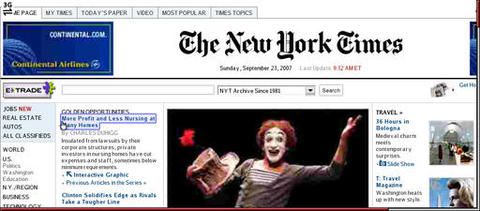
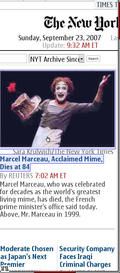 |
 |
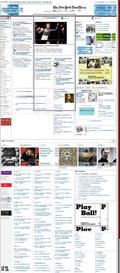 |
You can see that Opera Mini does an adequate job of laying out the page and displaying an overview (although there are still a few image artifacts in Beta 2) – what you can’t see is that it is extremely fast and enjoyable to use, letting me scroll around quickly and easily without using the E90’s feeble and unresponsive directional pad.
So much so, in fact, that the built in WebKit browser’s shortcomings (like the utter lack of any shorcut keys or its penchant for messing up something as simple as navigating form controls on a page) were thrown into sharp relief.
About the only thing that the WebKit browser got right were font sizes, since Opera Mini is still missing something decent between “Medium” and “Small” (which is, for the E90, preposterously tiny):

But the fact that I vastly preferred Opera Mini due to its extensive keyboard shortcuts is more evidence that Nokia really needs to overhaul their UI if they want to take advantage of full keyboards or provide power users with a decent experience.
For web browsing alone, their attempt at pawning off S60 on the Communicator crowd would indeed have backfired completely if it weren’t for the screen and connectivity.
Connectivity
Speaking of which, the E90’s is a pretty well-connected device – for starters, it has a standard mini-USB plug, which is a godsend (even if it does not allow you to charge the device).
And its HSDPA and Bluetooth support are nothing short of excellent, with it working fine as a modem and syncing up with my Mac using iSync and Nokia Multimedia Transfer with no hassles at all – I was able to sync all of my data (including podcasts and photos) entirely over Bluetooth, something you won’t be able to do with an iPod or iPhone anytime soon3.
Oh, and if you use iSync, your contacts will sync over with pretty much all the important (standard) fields preserved, including pretty good resolution photos.
Wi-Fi also coped well, although I found it rather disappointing in terms of both speed and battery life. The hotel I was at had free, unfettered Wi-Fi access in rooms and lounges, and yet I only used it when I wanted to surf the net but didn’t want to take calls (the phone’s offline mode lets you use Wi-Fi) because I found HSDPA to be just as fast, much more convenient (worked everywhere, including by the pool) and less of a strain on the battery.
And when the hotel’s Wi-Fi network went on the blink, I used the device as a Bluetooth modem on my iBook with no problems whatsoever.
Which reminds me, one thing most people don’t realize is that 3G lets you take calls while using the device as a modem or surfing – the device will simply squeeze the radio bearer for data to 64Kbps or so while the call is taking place and you won’t lose your connection – something that you can’t (reliably) do on GPRS or “EDGE”:Wikipedia:Enhanced_Data_Rates_for_GSM_Evolution (where the data connection is either completely suspended or dropped unless you are fortunate enough to have the one in a million combination of base station and phone chipsets that sort of works).
Add to that the ability to send arbitrary files to and fro without no hassle whatsoever (my current ringtone is the “marimba” tune from the iPhone, which I resampled to a sensible size and dropped in on a whim), and you have a very flexible and open device, able to hook up and talk to almost anything, anywhere.
And those of you who really want to print from a phone (a rather silly thing, but one that apparently matters to some people) will be glad to know that after some minor tinkering I can now print to my office printer from anywhere in the world:
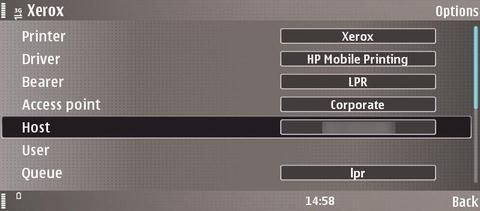
Not that I found any real use for it yet, mind you.
E-Mail, Calendar & Office Use
While on vacation, I had the opportunity to use four different e-mail accounts on the device: straight-up IMAP (SSL) access to my .Mac account, Windows Live, ActiveSync access to my corporate Exchange account, and the Java applet for Google’s GMail.
All but the last one relied on the device’s Messages application, which is still somewhat of a poor performer and suffers from the usual S60 bane of very poor font and letter spacing, which wastes screen real estate to no end.
But it worked well enough for most purposes, including dealing with attachments and meeting requests (a belated enhancement that has finally graced the version 2.0 ActiveSync client).
Calendaring is, I’m afraid, one of the weakest features of the device. It has no support for multiple calendars and its notion of all day events (at least those it synced from Exchange) borders on the picturesque (0:00-23:59, indeed…).
Plus the way in which it tries to emulate the original Series 80 month and week views in a split screen layout is a painful embarrassment, so people should not expect too much.
It works OK for me, but I keep everything in Exchange and rely on my phone mostly for meeting reminders and locations (which translate across from the meeting requests and appear on the device), so I’m probably not the best person to draft a detailed critique of the device’s organizing abilities (or lack thereof).
I was able to enter all kinds of events on my calendar on the move and sync them back to the server, tut it is pretty obvious to me that to-dos are unforgivably crippled – i.e., there are no categories whatsoever, and you can have as many lists as you want, provided you only want one.
Furthermore, the device appears to glean a particularly perverse enjoyment from wasting screen real estate – I cannot fathom why it sticks a broad, empty space between todo checkboxes and text like so:
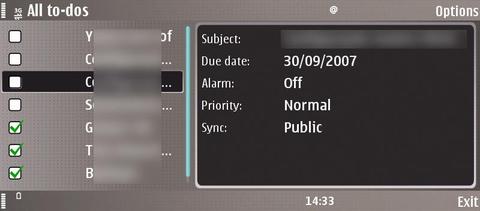
And yes, you can only see about ten characters of each item name – which renders the list itself completely useless.
As to Office attachment viewing, it was only let down by the bundled (and rather limited) QuickOffice’s inability to deal with both Office 2007 files and (most irritating of all) also some 2003-format PowerPoint files. I guess that’s progress for you4.
I won’t bore you with the details of messaging mechanics (other than mention that the Google applet tended to crash when replying to e-mail), so suffice it to say that I had all the niceties of a decent mail client – I could retrieve headers and look up people in my corporate directory, long messages in Exchange were retrieved on demand as I scrolled through them, and attachments were always handled at my leisure, saving bandwidth (and battery).
Battery Life
And what a grand battery it is. Locking the device into 3G only mode (to save it the trouble to keep electing neighboring cells with both radios), a single charge lasted me somewhere between two and three days, with the phone switched off at night and very heavy browser usage.
With occasional Wi-Fi and voice calls, however, it seldom lasted more than a day and a half – which makes sense, since in data mode the HSDPA radio use is pretty sparse, and power management features of the 3G network kick in between browser clicks – whereas Wi-Fi is a fairly unsophisticated protocol that works by dint of bleeding as much power as possible into the ether, and voice tends to keep the radio on constantly.
Applications, etc.
Although I didn’t have time to fool around with the built-in GPS, I did confirm my previous assertion that Nokia Maps is much more useful than Google Maps for European users.
For instance, searching for neighboring restaurants yielded a number of options, complete with additional details (not many, but handily beating the dearth of local POI information that Google has right now):
 |
 |
As to third-party apps, well… I’m not usually given to playing around with devices to that extent, but given that I was on vacation, I had time to download and fiddle around with a few.
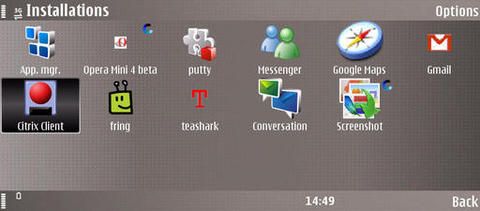
Citrix, for instance, worked well enough for me to pop in and forward a few documents to colleagues, although it is severely let down by the lack of decent keyboard shortcuts and the E90’s very poor directional “pad” – which, no matter what Nokia happens to believe, is an unsavory nuisance as far as I’m concerned.
And speaking of nuisances, here’s a screenshot of the latest thing I installed – the threaded SMS beta that I linked to the other day:

Notice how it, too, wastes screen real estate to no end.
Camera
Finally, and although I am not a fan of Nokia cameras (they usually skimp on the CCD and try to dress it up with optics that cannot possibly help a poor sensor5), the E90 also has a surprisingly good 3.2 megapixel camera with auto-focus that, despite a tendency towards washed color, does a pretty adequate job.
And it bears mentioning (even in passing) that the gallery application is one of the few places where a split screen layout actually makes sense:
 |
 |
But, as always, if you want to take decent pictures, don’t rely on a smartphone, no matter how many megapixels it has.
Conclusion
My overall feeling is that the E90 is an amazing piece of gear – but one that is in dire need of a UI overhaul in order to reap the full benefits of having a full-sized keyboard, and let down not only by its physical design but also by the way the UI wastes screen real estate.
I like it, but I will surely go back to the tiny, unobtrusive (and often faster) 6120 for daily office usage (at least until I get an E51 or something similar) and try to keep the E90 around to use on travels and the odd meeting or conference call.
And it bears mentioning that it is an amazing desktop speakerphone, and not just for voice – you can use it to do video-conferencing with excellent audio and video quality6.
The highest recommendation I can give it is that I was able to do pretty much everything I needed while away from the office (with little compromise besides what I outlined above), and that if you want browsing on the go, the iPhone is the only device likely to beat it – but, as always, there are compromises hidden in every choice.
—
1 My current mental analogy is likening it to suffing a pig into a Mini – the pig actually has quite a bit of room to waddle in, except it can’t quite turn around inside or handle the steering wheel (and yes, judging from a brief stint in the motorway, there are some right pigs driving out there).
2 That is the only sense in which I regret not having brought along an E61i instead, which despite the cramped keypad and smaller screen has always allowed me to thumb type with speed and confidence.
3 Sure, it’s not as fast as USB, but it is extremely convenient and lets you keep using the phone. Plus the device appearing as a camera in iPhoto is an exceptionally nice touch.
4 Oddly enough, some PDF files were also unviewable (with the dreaded “Out of memory” errors), but I cannot fault the viewer software for that. And yes, you can upgrade to the full version, but why should I do so (or even get a Nokia device) when, for instance, Windows Mobile has better bundled support for Office files?.
5 The technical term is, I believe, “to put lipstick on a pig”.
6 I know that people usually shun VT, but in my work environment it is just another type of call.